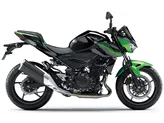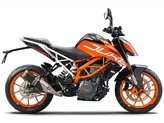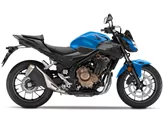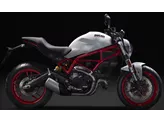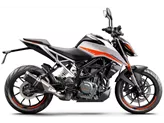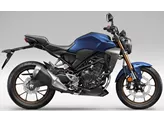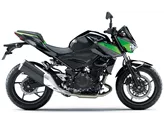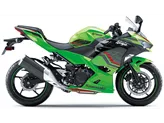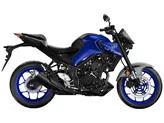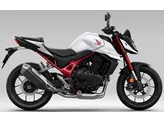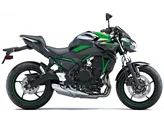Kawasaki Z650 2017 vs. Kawasaki Z 400 2019

Kawasaki Z650 2017

Kawasaki Z 400 2019
Overview - Kawasaki Z650 2017 vs Kawasaki Z 400 2019
The Kawasaki Z650 2017 and the Kawasaki Z 400 2019 are both naked bikes from Kawasaki, but they have some notable differences in terms of their technical specifications and strengths.
Starting with the technical specifications, both bikes have an in-line engine type, liquid cooling, and fuel injection. However, the Z650 has a larger engine displacement of 649cc compared to the Z 400's 399cc. This results in the Z650 having a higher engine power of 68.2 HP, while the Z 400 has a slightly lower engine power of 45 HP. Similarly, the Z650 has a higher torque of 65.7 Nm compared to the Z 400's 38 Nm.
In terms of suspension, both bikes have a telescopic fork front suspension and a swing arm rear suspension with a monoshock absorber. However, the Z650 has the advantage of having preload adjustment for the rear suspension, allowing for some customization. The chassis for both bikes is made of steel and has a tubular frame type.

Kawasaki Z650 2017
When it comes to braking, the Z650 has double disc brakes at the front with a diameter of 300mm and double piston technology. On the other hand, the Z 400 has a single disc brake at the front with a larger diameter of 310mm and double piston technology. Both bikes also have ABS as an advanced rider assistance system.
In terms of dimensions and weights, the Z650 has a wider front tire width of 120mm compared to the Z 400's 110mm. However, the Z 400 has a slightly wider rear tire width of 150mm compared to the Z650's 160mm. Both bikes have the same front and rear tire diameter of 17 inches. The Z650 has a longer wheelbase of 1410mm compared to the Z 400's 1370mm. The seat height is slightly lower for the Z 400 at 785mm compared to the Z650's 790mm. Additionally, the Z 400 is lighter with a kerb weight of 167kg compared to the Z650's 187.1kg. Both bikes have a fuel tank capacity of 14 liters for the Z 400 and 15 liters for the Z650.

Kawasaki Z 400 2019
Moving on to their strengths, the Z650 2017 is praised for its even power delivery, sporty chassis, compact dimensions, and negative display. On the other hand, the Z 400 2019 is commended for its great and very controllable power delivery, low weight, good seating position, great sound, and suitability for novice riders.
However, both bikes have their weaknesses as well. The Z650 is criticized for being a little too small for tall people, while the Z 400 has non-adjustable clutch and brake levers and limited adjustable chassis.
In conclusion, the Kawasaki Z650 2017 and the Kawasaki Z 400 2019 have their own unique features and strengths. The Z650 offers more power and adjustability, making it suitable for riders who prefer a sportier experience. On the other hand, the Z 400 is lighter and more beginner-friendly, making it a great choice for novice riders.
Technical Specifications Kawasaki Z650 2017 compared to Kawasaki Z 400 2019
Pros and Cons in comparison
Pros and Cons in comparison
Kawasaki Z650 2017

The Kawasaki Z 650 is the tip of the middle class for small male and female riders. On its compact dimensions, you probably won't feel comfortable as a giant. Heart-warming feelings, however, come from the engine, which delights with a very smooth pull. On the chassis side, a Kawasaki-typical tight set-up was chosen, which finds a great compromise in everyday use. The negative display is very easy to read and is reminiscent of its predecessor, the ER-6n - very nice!
Kawasaki Z 400 2019

The Kawasaki Z400 is definitely a great evolution of its predecessor, the Z300. More power, less weight - all around, simply an even better bike. Above all, the linear power delivery and excellent handling make the Z400 an ideal entry-level bike. The ease of clutch operation and good chassis set-up are also in this vein, which is why the Z400 can be recommended to novice riders without hesitation.
Price Comparison Avarage Market Price Kawasaki Z650 vs Kawasaki Z 400
There are a few key differences between a Kawasaki Z650 2017 and a Kawasaki Z 400 2019. In terms of price, the actual average price of a Kawasaki Z650 2017 is about 25% higher. A Kawasaki Z650 2017 experiences a loss of 350 GBP in one year of ownership. This is offset by a loss of 270 GBP for a Kawasaki Z 400 2019. Compared to Kawasaki Z 400 2019 there are more Kawasaki Z650 2017 bikes available on the 1000PS.de Marketplace, specifically 11 compared to 6. It takes less time to sell a Kawasaki Z650 with 76 days compared to 99 days for a Kawasaki Z 400. Since model year 2017 1000PS.de editors have written 31 reviews for the Kawasaki Z650 and 8 reviews for the Kawasaki Z 400 since model year 2019. The first review for the Kawasaki Z650 was published on 08/11/2016 and now has more than 25,000 views. This compares to more than 23,200 views for the first review on Kawasaki Z 400 published on 02/10/2018.




